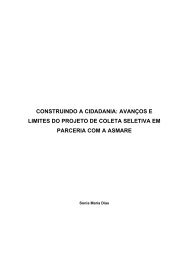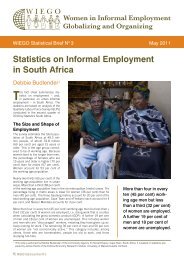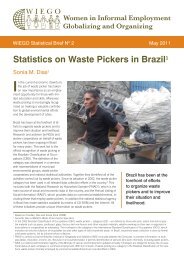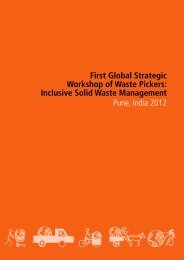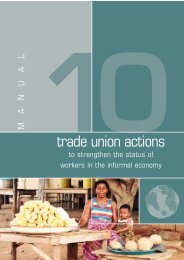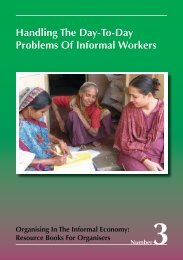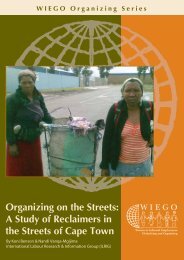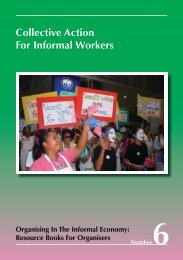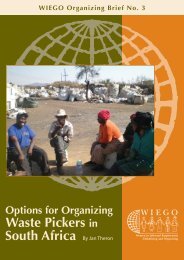Informal Economy Budget Analysis in Philippines and ... - WIEGO
Informal Economy Budget Analysis in Philippines and ... - WIEGO
Informal Economy Budget Analysis in Philippines and ... - WIEGO
Create successful ePaper yourself
Turn your PDF publications into a flip-book with our unique Google optimized e-Paper software.
<strong>WIEGO</strong> Work<strong>in</strong>g Paper N o 12<strong>in</strong> 1983 as a formalised system of waste pickers <strong>and</strong> it<strong>in</strong>erant buyers of recyclables work<strong>in</strong>g for a particular<strong>in</strong>termediary <strong>in</strong> the City of San Juan. There are now cooperatives <strong>in</strong> each of the 17 cities <strong>and</strong> towns thatcomprise Metro Manila, <strong>in</strong>clud<strong>in</strong>g the 897 <strong>in</strong>termediaries <strong>and</strong> approximately 1,500 eco-aides. 6 Underthe programme, each waste picker (called ‘eco-aide’) has a fixed route; <strong>and</strong> purchases source-separatedrecyclables from households <strong>and</strong> schools. Eco-aides wear green uniforms <strong>and</strong> use green pushcarts orbicycles. Waste pickers affiliated with the programme recover 4,000 tons of recyclable materials per month.The cooperatives can obta<strong>in</strong> low-<strong>in</strong>terest <strong>and</strong> collateral-free loans from the Department of Trade <strong>and</strong>Industry (DTI) <strong>and</strong> from the government-owned L<strong>and</strong> Bank of the Philipp<strong>in</strong>es (LBP).From <strong>in</strong>formal sector to <strong>in</strong>formal economyWhere no efficient social protection schemes or social safety nets exist, the Filip<strong>in</strong>o work<strong>in</strong>g poor cannotafford to be openly unemployed <strong>and</strong> must work to survive <strong>and</strong> support the family. By work<strong>in</strong>g poor is meantthose who are work<strong>in</strong>g but cannot work their way out of poverty because of very low earn<strong>in</strong>gs <strong>and</strong> very highrisks.Figures based on the 2005 National Labour Force Survey (LFS) show that the Philipp<strong>in</strong>e <strong>in</strong>formal sectornow comprises 76.3 percent or 24.6 million of the country’s total employed, an <strong>in</strong>crease of severalpercentage po<strong>in</strong>ts from previous estimates. This rise <strong>in</strong> <strong>in</strong>formal sector employment is accompanied byan alarm<strong>in</strong>g decrease <strong>in</strong> the ranks of formal workers. The NSCB reported that <strong>in</strong> 2007, 43 percent of thecountry’s Gross Domestic Product (GDP) came from the <strong>in</strong>formal sector. 7 As the catchment bas<strong>in</strong> of allthose displaced from formal work who have no other choice but to create their own employment or become<strong>in</strong>formal employees, the <strong>in</strong>formal sector has contributed a sizeable share to the coffers of the economy.However, the concerns of the <strong>in</strong>formal sector are not <strong>in</strong>tegrated <strong>in</strong> the MTPDP. Hence, there is a deficit ofprogrammes <strong>and</strong> projects <strong>in</strong>tended specifically for their upliftment. In the yearly General Appropriations Act(GAA) for example, there is an obvious lack of programmes for their protection <strong>and</strong> socio-political-economicempowerment.Statistics about <strong>in</strong>formal workers are not easy to generate from the LFS <strong>and</strong> determ<strong>in</strong><strong>in</strong>g their precisenumber has been a cont<strong>in</strong>u<strong>in</strong>g struggle. Often, the extent of <strong>in</strong>formal work is estimated from the numbersof the own account <strong>and</strong> unpaid family workers <strong>in</strong> the LFS. The NSCB issued the follow<strong>in</strong>g operationaldef<strong>in</strong>ition of the <strong>in</strong>formal sector after consultations with stakeholders:Units engaged <strong>in</strong> the production of goods <strong>and</strong> services with the primary objective of generat<strong>in</strong>g employment<strong>and</strong> <strong>in</strong>comes to the persons concerned. It consists of household un<strong>in</strong>corporated enterprises that aremarket <strong>and</strong> non-market producers of goods as well as market producers of services. These enterprisesare operated by own-account workers, which may employ unpaid family workers as well as occasional,seasonally hired workers. These enterprises may also be owned <strong>and</strong> operated by employers which mayemploy less than 10 employees on a cont<strong>in</strong>uous basis. 8Thus, as officially recognised <strong>and</strong> def<strong>in</strong>ed, the <strong>in</strong>formal sector <strong>in</strong>cludes the follow<strong>in</strong>g sub-sectors, amongothers: micro-entrepreneurs, home-based workers (<strong>in</strong>clud<strong>in</strong>g sub-contracted, own account workers<strong>and</strong> self-employed), vendors, small transport operators (tricycles, pedicabs <strong>and</strong> bancas), petty retailers,barter traders, small-scale m<strong>in</strong>ers <strong>and</strong> quarry workers, non-corporate construction workers, enterta<strong>in</strong>ers,beauticians, laundry persons, hairdressers, small <strong>and</strong> l<strong>and</strong>less farmers, artisanal fisher-folk, on-calldomestic helpers, volunteer workers, barkers, unorganised cargo h<strong>and</strong>lers, <strong>and</strong> waste collectors.6Much of the <strong>in</strong>formation represents details at the time the study was undertaken.7Factsheet on Filip<strong>in</strong>o Women, March 2008, retrieved from www.ncrfw.gov.ph/<strong>in</strong>side_pages/downloads/factsheets_on_filip<strong>in</strong>o_women_03_2008.pdf8NSCB Resolution No. 15, Series of 20025



